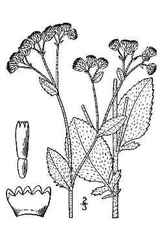
AKRON, Ohio—Dependent on what they could grow themselves, early settlers to Northeast Ohio made a point of bringing seeds or plants with them. One was costmary, likely transported as a rhizome (root), since it produces few seeds. Today costmary grows in the circa 1815 herb garden recently recreated by the Bath Gamma Garden Club at Hale Farm and Village.
Costmary (Tanacetum balsamatica) is a perennial herb hardy to Zone 4. It has a pleasant, balsam-like fragrance. The common name comes from Latin costus (aromatic oriental plant) and Maria, a tribute to the Mother Mary. Grown in sun, it produces unimpressive
Costmary leaves had many uses for Ohio pioneers. Medicinal applications for sinusitis, insect bites and gunpowder burns were mentioned as early as the 15th Century, but today, costmary is no longer used as medicine. As an aromatic, costmary had many uses. An infusion of 2 tablespoons dry costmary in 2 ½ cups boiling water, simmered for two hours, was added to the rinse water for linens. A blend of dried costmary and lavender scented linen closets. Costmary was strewn on the floor so a footstep would release a pleasant scent. Today we might enjoy adding a few leaves to hot bath water.
Costmary was also called “Bible Leaf” because a leaf makes a nicely scented bookmark, while repelling silverfish and book lice. It was often used in the family Bible, where the strongly scented leaf could be sniffed or nibbled covertly as a “revival” during the often long and mind-numbing Sunday services. Caution: any leaves to be placed in books should first be thoroughly pressed and dried between sheets of absorbent paper. Costmary also flavored ales and wines, earning the alterative name, Alecost. The modern gardener might enjoy a leaf or two in lemonade or iced tea.
You can see and smell costmary in the herb garden of the Salt Box House at Hale Farm & Village, planted and tended by the Bath Gamma Garden Club since 2010. The club provides Plant of the Month articles as part of its mission to provide gardening information to all. Founded in 1957 to share an interest in and love of gardening, the club promotes the beautification of Bath and protects native plants. Call club president Patti Sinar at 330-659-3289 for more information about attending and joining.

 RSS Feed
RSS Feed